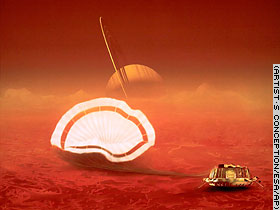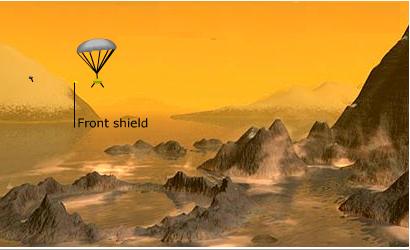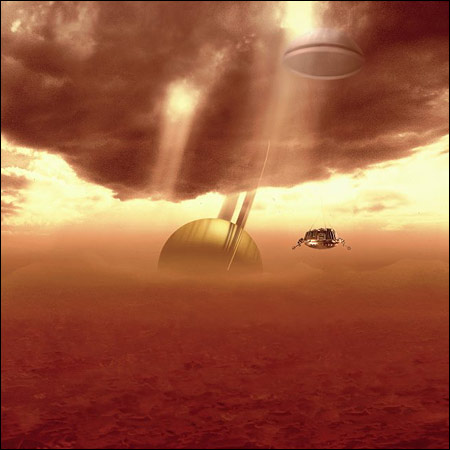The concentration of the reports from that day, as they appeared on the old site in real time
20:45 The first image from Titan is expected around 22:00

14.1.2005
20:30 The European Space Agency has confirmed that it has started receiving data from Huygens. They expect to see the first image starting around 21:45 Israel time. The data was transferred from the European spacecraft to the Cassini spacecraft and then transmitted to Earth. Scientists are interested in Titan because of its chemistry which is apparently quite similar to that of the early Earth before life arose
Update 19:00 - Joy at the European Space Agency:
The "Huygens" spacecraft landed on the moon "Titan"
The European spacecraft "Huygens" successfully landed on the surface of Titan, a moon of the planet Saturn. The parachute, which is supposed to slow down the spacecraft's landing on the moon, opened as it was supposed to when it entered the atmosphere of the planet, which allowed it to land safely.
Not only signals from the road but also signals from the landing were picked up by radio telescopes.
The Huygens spacecraft transmitted to scientists at NASA and the European Space Agency ASA a signal indicating that it had landed on Titan. Radio telescopes all over the world confirmed that the spacecraft survived the penetration into the atmosphere, opened its three parachutes in time and landed on the icy surface of the large Saturnian moon.
Although the spacecraft was designed to survive only a few minutes after landing on Titan, it transmitted data to Cassini, which orbits Saturn for over two hours after landing.
Cassini continued to receive the data until it passed beyond Tetan's horizon and out of the small spacecraft's transmission range. Cassini has now turned its large antenna towards the Earth and is transmitting the data to the scientists who are waiting for them in Darmstadt, Germany, including Prof. Akiva Bar Nun from Tel Aviv University.. They hope that the data survived the transfer. Bob Mitchell, manager of the Cassini-Huygens program on behalf of NASA says. "We know that the spacecraft completed the penetration into the atmosphere, the descent into it, reached the surface and continued to transmit for at least an hour and a half." said. "What we don't know is how the instruments worked, how Cassini, which mediated between us, worked and whether the information arrived without loss."
The scientific information also started to flow to the earth, we will know details later this evening.
Huygens landed on the surface of Saturn around 14:45 Israel time and the scientists are waiting for the valuable information from the cloud covered moon.
19:10 Huygens survived about two hours after her landing and the connection was interrupted only because she sank beyond the horizon to Cassin

Now it remains to wait for the data and see which of the devices worked properly and what information was produced from them
Previous update - as of 17:00 - the Huygens spacecraft has landed. She sent a signal indicating that she was carrying out her mission
Avi Blizovsky
CNN reports from the director of the Huygens program at the European Space Agency that the spacecraft has landed. The landing apparently took place at 14:45 Israel time.
"We have a signal. We know that Huygens is alive, which means that the dream has come true," said Jean-Jacques Dordin, program manager for the European Space Agency.
Earlier, the BBC reported that the Huygens spacecraft transmitted to Earth at noon the first sign of life from its historic mission by landing on Saturn's moon Titan.
Earlier today (Friday, 14/1/05), Huygens began diving into Titan's atmosphere, taking pictures and taking measurements while parachuting toward the surface. Huygens' scientific investigation of the mysterious world may provide clues to the question of how life first began on Earth.
Ground controllers detected it from Huygens indicating that it was alive through a network of sensitive radio telescopes. "It's like hearing the cry of a newborn baby," said Jean-Pierre Lebreton, director of the Huygens mission at the European Space Agency.
"The signal tells us that the spaceship is alive, that everything went successfully and that it is currently in descent using the parachutes. The Huygens systems should now transmit the data to Cassini. The descent was supposed to last about two hours (see the landing schedule on Titan).
Much more detailed data should be received in the evening and at night. Then the first image of an alien world that scientists have been waiting for for a long time will arrive. "This is the most exotic place we've ever seen," said Cassini-Huygens mission scientist Candice Hansen. "We have never landed on the surface of a glacial moon. We know from the photos that there were geological processes of a different kind."
The Cassini-Huygens spacecraft, which cost about $3.3 billion shared between NASA, the European Space Agency and the Italian space program, was designed to study Saturn and its 33 known moons. Both vehicles were launched together from Florida in 1997.
"The mission is designed to study the entire Saturn system in greater detail than has been possible so far. The atmosphere, the internal structure, the satellites, the rings and the magnetosphere," said Cassini program manager at NASA, Bob Mitchell. The Huygens spacecraft, which is about the size of a Volkswagen Beetle, has been slowly spinning toward Titan since separating from Cassini on December 24. Cassini will remain in orbit around Saturn at least until July 2008. "The mission will help answer some of the big questions that NASA is interested in about the origin of the planets and where life came from." Mitchell said.
Tital's atmosphere, a dark mixture of nitrogen, methane and argon, resembles that of Earth 3.8 billion years ago. And the scientists believe that its investigation will shed light on the beginning of life. However, "the possibility of finding living beings is a faint possibility." Hansen said. "Although this is not ruled out, it is not the question that is on the list of priorities. This is a cold world. Lack of solar energy turns Titan into a deep freeze. The temperature does not rise above minus 180 degrees Celsius, which causes the water to freeze and delays the chemical reactions necessary for organic life."
Advance notice
The landing schedule on Titan: entry into the atmosphere 11:07, initial information about the success - 12:30

The Huygens spacecraft will enter Titan's atmosphere at 09:07 GMT (11:07 Israel time) and will land shortly after. Then it will also transmit a weak signal towards Earth and towards its mother spacecraft, Cassini.
Ground controllers may receive the first signal from Huggins at the earliest at 10:30 a.m. GMT from sensitive radio telescopes listening to the frequency on which the robotic spacecraft is transmitting.
"This will give us an indication that the spacecraft is functioning well and that it has penetrated Titan's atmosphere," says Dr. Jean-Pierre Leverton, the lead scientist on the Huygens project, to journalists at the European Control Center in Darmstadt, Germany.
and to the full schedule as published by the European Space Agency. Times are according to Greenwich Mean Time.
05:51 GMT - A timer activated an electrical system that woke up the system that had been in "sleep" mode to save energy. From this time the spacecraft was supposed to start broadcasting.
10:13 Huygens will reach the entrance to the atmosphere - defined as a height of 1270 km above the surface of the moon Titan - the moment of penetration is of course a critical moment.
10:17 The flight parachute will open and slow the speed of the spacecraft to 400 meters per second at a height of about 180 km above the surface.
The flight parachute is the smallest of the spacecraft's parachutes - it is only 2.6 meters in diameter and its purpose is to pull the spacecraft's back cover that protects Huygens from the heat of friction upon entering the atmosphere.
2.5 seconds after the flight chute opens, the back cover will be released and the small chute will separate from the spacecraft. The main parachute - which is 8.3 meters in diameter will deploy.
10:18 Huygens will begin transmitting to Cassini and release the front shield at an altitude of 160 kilometers above the surface.
42 seconds later, small hatches will be opened to allow several instruments - the gas chromatograph, the mass spectrometer and the aerosol collection device - to be exposed to the atmosphere.
The descent radiometer will capture the first panoramic image and continue to capture and provide spectral data throughout the descent. The scientific package that will operate on the surface will also be turned on and measure the properties of the atmosphere.
10:32 - The main chute will separate and open a smaller chute, also defined as an anchor, which is 3 meters in diameter. At this height in the atmosphere, about 125 kilometers. This chute will allow the spacecraft to descend at the right rate to collect the maximum possible data.
1049: All actions so far will be performed automatically. At an altitude of 60 kilometers, the spacecraft will be able to find its own altitude using two radar-based altimeters, which will include measuring the exact distance to the surface. The spacecraft will constantly monitor the rotation rate and altitude and feed this data to the scientific instruments. As such the times from here on are approximate.
1157 – The gas chromatograph. The mass spectrograph will start by sampling the atmosphere. This is the last Huygens device to be fully operational. The full descent will last 137 minutes, plus or minus 15 minutes. During the descent, the spacecraft will continue to spin at a rate of one revolution per 20 revolutions and allow the camera and other instruments to see a panoramic image around the descending spacecraft.
12:30 close to the surface of the earth a light will be lit in the camera. The light is especially important to the spectral radiometer - part of an instrument used to determine the exact composition of Titan's surface.
12:34 Touching the surface. This time may change plus or minus 15 minutes depending on the effect of the atmosphere and winds on the Huygens parachutes. The spacecraft will reach the ground at a speed of 5-6 meters per second. Huygens may land on rocky or glacial terrain or in a sea made of ethane. In any case, the surface science suite is designed to collect every piece of information about the surface that can be diagnosed in the six minutes that Huygens is expected to survive after landing.
14:44 Cassini will stop collecting data from Huygens
Even if the spacecraft survives, it will simply sink beyond Titan's horizon as seen from Cassini and it will stop collecting data. Cassini will listen for signals from Huygens as long as there is even the faintest possibility that those signals can be detected. Once the Huygens landing site disappears below the horizon, there is no longer any chance of hearing signals. Huygens' work will come to an end.
15:14 - The first data will be transmitted to Earth. Cassini's main antenna, which will be pointed at Titan throughout the day, will be aimed at Earth and then the first batch of data will be transmitted.
Receiving data from Cassini is now a routine operation, but in the Huygens mission security mechanisms were added to ensure that no data sent from Huygens would be lost. In addition to the deep space network's permanent antennas used to listen to the transmissions of the spacecraft on distant missions, huge radio antennas around the world will also listen to Cassini as it transmits back copies of the Huygens data.
